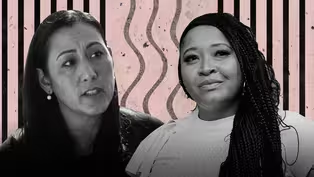
Are Asians Next in Line to be White?
Season 1 Episode 4 | 7m 50sVideo has Closed Captions
Unpacking the stereotype that Asians are next in line to be white.
By taking a look at the movies Get Out and Do The Right Thing, Adrian and Dolly examine pop culture references about Asian proximity to whiteness. They connect these moments to 3 historic Supreme Court cases where Asian Americans sued for white privilege and their discussion builds upon the theory’s of Cheryl Harris, a law professor who examines whiteness as a form of ownership.
Problems playing video? | Closed Captioning Feedback
Problems playing video? | Closed Captioning Feedback

Are Asians Next in Line to be White?
Season 1 Episode 4 | 7m 50sVideo has Closed Captions
By taking a look at the movies Get Out and Do The Right Thing, Adrian and Dolly examine pop culture references about Asian proximity to whiteness. They connect these moments to 3 historic Supreme Court cases where Asian Americans sued for white privilege and their discussion builds upon the theory’s of Cheryl Harris, a law professor who examines whiteness as a form of ownership.
Problems playing video? | Closed Captioning Feedback
How to Watch A People's History
A People's History is available to stream on pbs.org and the free PBS App, available on iPhone, Apple TV, Android TV, Android smartphones, Amazon Fire TV, Amazon Fire Tablet, Roku, Samsung Smart TV, and Vizio.
Providing Support for PBS.org
Learn Moreabout PBS online sponsorshipMore from This Collection
Produced in partnership by the Center for Asian American Media and PBS Digital Studios, A People’s History of Asian America tells the history of Asian Americans through the microaggressions and stereotypes this community faces.
Are You “AAPI” or “Asian American”? It's Complicated.
Video has Closed Captions
Explore the pros and cons of disaggregating Asian American as a statistical category. (11m)
Where Did The “Asian Fetish” Come From?
Video has Closed Captions
Where does the Asian fetish come from? (7m 40s)
Why “The China Virus” Has Always Been A Part Of U.S. History
Video has Closed Captions
This xenophobic sentiment has resulted in a cycle of violence dating back to the 1800s. (9m)
Providing Support for PBS.org
Learn Moreabout PBS online sponsorshipWe've reached the last episode of our mini series.
Nooooooooooo!
That's so sad.
Since it's our final one, why don't we think about exploring a more philosophical question for this episode?
I like that idea.
What do you have in mind?
All right.
I'll set the stage for us with a few lines from one of our favorite writers, Cathy Park Hong.
When I hear the phrase, "Asians are next in line to be white.
I replace the word white with disappear.".
Asians are next in line to be white.
I have definitely heard that before and it always really, really bothered me.
because I feel like it's such a racist sentiment, yet it's hard to pinpoint exactly why.
Well, why don't we tackle that question in this last episode, are Asians next in line to be white?
Welcome to A People's History of Asian America.
Remember that scene and get out where there's that one Asian guy at that all white barbecue?
Oh, trust me.
I remember.
We first see him when Daniel Kaluuya's character, Chris, thinks he's meeting his white girlfriend's family, except all these white people are actually there to buy his body.
Including that one Asian guy.
But then there's also the movie Do the Right Thing where there's that one Asian grocery store in a predominantly black neighborhood.
Twenty C Energizers?
D. Not C. D. When Sal's pizzeria is set ablaze, Sunny, the Korean store owner becomes a target of the mob.
"".
"I no white!
I no white!
I'm black!"
"He's black?
Me black!"
"You, me, same."
And he tries to defend himself shouting.
I'm black, I'm black.
As if that's going to keep him safe.
You could see the confusion among Black folks in this scene too.
Does this Korean man have white privilege?
Cause he's certainly not Black, but still as a store owner, he's financially benefiting from Black people.
What I think is so brilliant about both of these movies is their commentary on Asian proximity to whiteness.
In Get Out the Asian character aligns himself with whiteness so much that he participates in the oppression and potential murder of a Black person.
In Do The Right Thing the Asian character aligns himselves against whiteness so much that he claims Blackness, but only when it was convenient for him to save himself.
Understanding how the idea of whiteness has been constructed is central to the violence depicted in both of the movies that we talked about.
But it is also central to answering our question our Asian people next in line to be white.
So how did we arrive on the modern concept of whiteness?
Let's turn to critical race theorist, Cheryl Harris.
Now, according to professor Harris, whiteness isn't just about skin color.
Whiteness is actually inscribed into the law itself, specifically in how certain people could own property at the expense of others.
There are two ways this manifested in American history, number one, Black people could not possess their bodies and labor.
And number two native people could not possess land and natural resources.
So what you're saying is whiteness isn't just about race or skin color.
It's actually about the exploitation of land and people.
Exactly.
And we could see how Asian Americans have attempted to claim legal whiteness multiple times in history and were then shown their place in America's racial hierarchy.
1922.
Ozawa vs the United States.
Takao Ozawa was born in Japan and lived in the US for 20 years.
He applied for naturalization, which at that time was only offered to free white persons or persons of African descent.
Instead of challenging the constitutionality of these racial restrictions Ozawa claimed that Japanese people, because they were so light-skinned should be considered free white persons.
The Supreme Court unanimously ruled against Ozawa stating that the words white person only referred to those of the Caucasian race.
But even Caucasian was not enough.
Whiteness as a concept, continued to evolve.
1923.
Thind vs the United States.
Just a year later using the logic from Ozawa's case, a Sikh Punjabi American also tries to sue for naturalization by claiming that he's technically of the Caucasian race by being an area in descent and a high caste Hindu.
But the Supreme Court ruled against Bhagat Singh Thind, changing their definition of whiteness and Caucasian to be defined by the perception of the common man, AKA the socially acceptable definition of white.
And this is how the law acknowledged that race is a social construct.
To paraphrase Professor Harris, whiteness emerged as an ideology and a legal framework to ensure that a certain group of people held power over others.
And as if Asian Americans didn't learn their lesson the first two times they sued for whiteness, five years later there was yet another attempt.
This time in the Mississippi Delta during the age of racial segregation.
1927, Lum versus Rice.
Gong Lum, a Chinese American grocery store owner in the south sues his local white public school for kicking out his daughter, Martha Lum for being colored.
Instead of claiming that segregated schools are inherently unequal, the Lum family tries to claim that Martha Lum was not colored.
The court unanimously ruled against the Lum family stating that segregated education was to be divided between the pure white or Caucasian race.
And colored people, which explicitly meant the brown, yellow, and black racism.
And because Martha Lum was supposedly part of the Mongolian or yellow race, she could not be enrolled in white schools.
Yet another case that brings home the point that no matter how lightskinned, how financially successful, how model of a minority Asian people may be, they will never be considered white.
All of this goes to show that claiming whiteness will never work as a response to racial injustice because whiteness and white supremacy is actually about producing and maintaining inequality.
And two, resorting to anti-blackness will not only hinder justice for Asian Americans, but all communities who are perceived as not white.
To close off this last episode of our show, A People's History of Asian America -- your favorite show -- Here are the powerful words of Cathy Park Hong, once again, exploring why whiteness will make Asian people disappear.
When I hear the phrase, Asians are next in line to be white, I replace the word white with disappear.
Asians are next in line to disappear.
We are reputed to be so accomplished.
And so law abiding, we will disappear into this country's amnesiac fog.
We will not be the power, but become absorbed by power, not share the power of whites, but be stooges to a white ideology that exploited our ancestors.


- Science and Nature

A documentary series capturing the resilient work of female land stewards across the United States.












Support for PBS provided by:




